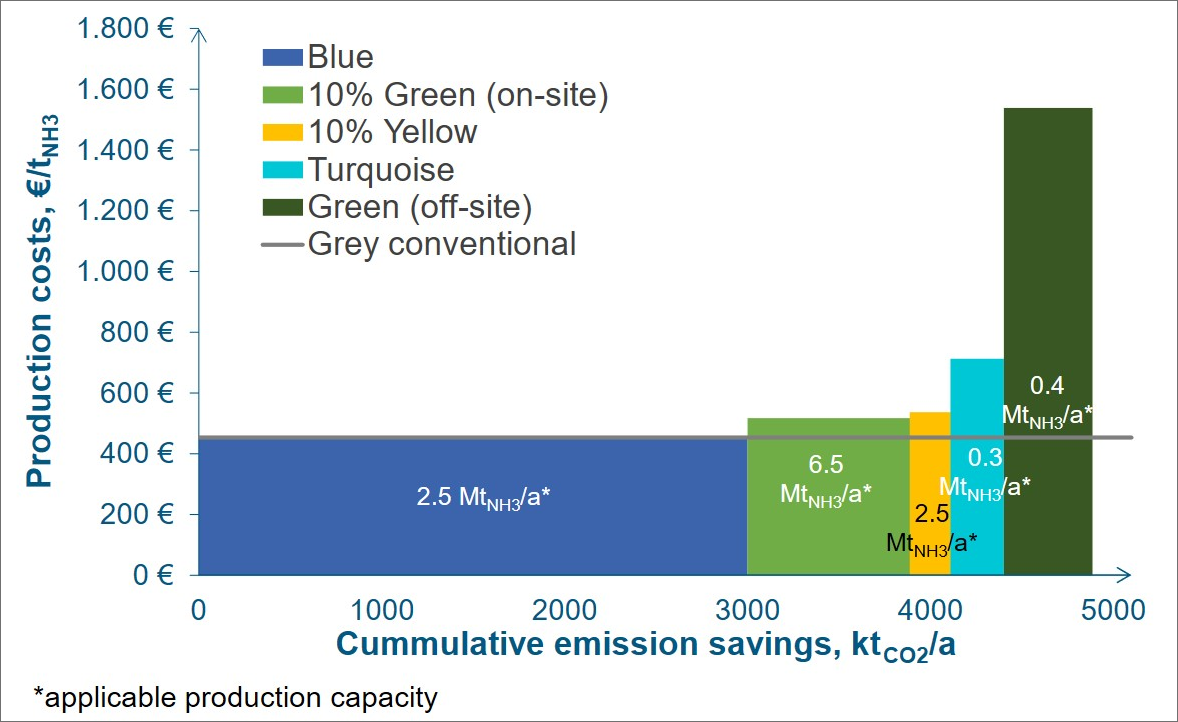
Reduktion der CO2 Emissionen und Produktionskosten pro Tonne Ammoniak bei Verwendung neuer Technologien zur Wasserstoff-Produktion im Jahr 2030 (Bestmögliches Szenario) © DECHEMA e.v. / Ausfelder, F. et al.
Carbon dioxide emissions from ammonia production in Europe could be cut by almost a fifth in 2030
A new report titled “Perspective Europe 2030 - Technology options for CO2-emission reduction of hydrogen feedstock in ammonia production” analyzes different options for existing European ammonia production plants to reduce CO2-emissions with a focus on 2030. The results highlight the potential of new hydrogen technology to tackle climate change. The study was commissioned by Fertilizers Europe and carried out by DECHEMA.
The production of ammonia is one of the largest industrial sources of carbon dioxide emissions globally, mainly because conventional hydrogen used in this process is generated using fossil resources. Implementing new hydrogen technology could decrease the carbon dioxide emissions during ammonia production by approximately 4,900 kt per year in 2030. Compared to today this would amount to be 19 % carbon dioxide less than is currently emitted during the ammonia production, a study from German DECHEMA e.V. now finds.
The authors of the study looked at a variety of technology options by which conventional hydrogen feed generation may be partially substituted in the near future. These include conventional hydrogen production coupled with Carbon Capture and Storage (CCS, blue hydrogen), the introduction of electrolytic hydrogen production with grid (yellow hydrogen) or green electricity onsite (green hydrogen), green hydrogen generated off-site and supplied via pipeline and (turquoise) hydrogen supplied via methane pyrolysis.
Each technology option is associated with different production costs, energy and infrastructure requirements which the authors considered. Based on this, the team also mapped out the possible implementation of the technology options in different European regions in view of the prospective availability and cost of renewable electricity, assumed availability of infrastructure (power, hydrogen, CO2) as well as policy constraints towards CCS. To calculate the overall abatement potential in ammonia production, researchers estimated a base and a best-scenario and compared them to a conventional production path.
The analysis shows that the largest decrease in carbon dioxide emissions from ammonia production in 2030 in Europe is expected to be made possible by the implementation of blue hydrogen (3,000 kt CO2 emissions less per year). Emissions may be further cut by a partial substitution (10 %) of conventional hydrogen with electrolytic green hydrogen onsite and electrolytic yellow hydrogen onsite. This would lead to 900 kt and 200 kt carbon dioxide emissions less per year respectively. In addition, contributions from green hydrogen via pipeline and turquoise hydrogen could reduce CO2 emissions by 500 and 300 kt per year.
While the new hydrogen technology options are associated with higher production costs compared to conventional production, the researchers also included assumptions about prospective developments in renewable electricity, imported green hydrogen and CO2 costs. As a result, the implementation of blue hydrogen is expected to produce ammonia at costs at par with conventional technology in 2030. In contrast the use of electrolytic green hydrogen onsite and electrolytic yellow hydrogen as well as green hydrogen via pipeline and turquoise hydrogen would result at significantly higher production costs.
The remaining global greenhouse budget, in accordance with the Paris Climate Agreement, requires each sector to reduce greenhouse gas emissions at a short timescale. “A key question therefore is ‘What is the realistic greenhouse gas abatement potential of plants that are currently in operation?’ Our study shows that by implementing new hydrogen technologies, the European fertilizer industry could significantly contribute to the reduction of carbon dioxide emissions within the timeframe up to 2030”, Dr. Florian Ausfelder, main author of the study, DECHEMA e.V., concludes.
The study is available online:
https://dechema.de/dechema_media/Downloads/Positionspapiere/Studie+Ammoniak.pdf
For further information please contact:
Dr. Florian Ausfelder
Luisa López
Eghe Herrmann
10/22
back to overview
© DECHEMA e.V. 1995-2025, Last update 17.01.2025

